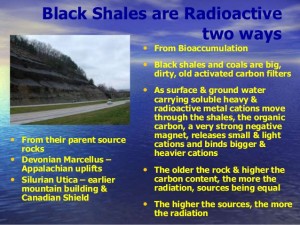From an Article by the Associated Press, WV Public Broadcasting, December 19, 2017
Environmentalists have reached an agreement with Antero Treatment that calls for monitoring for radioactivity and bromide around its landfill in northern West Virginia that takes the waste from recycled groundwater used in hydraulic fracturing for natural gas.
It settles an appeal by the West Virginia Rivers Coalition and West Virginia Highlands Conservancy of the state permit for the landfill, which takes salt byproducts from Antero’s adjacent wastewater recycling facility. Both are located on 447 acres in Ritchie and Doddridge counties.
The environmental groups say the permit allows discharging stormwater runoff and associated pollutants into tributaries of the Hughes River upstream within 5 miles of Harrisville’s public water system intake.
“This is one example of how the state is tasked with evaluating new sources of pollution brought about by the fracking boom,” said Angie Rosser, executive director of West Virginia Rivers Coalition. “We need to find out sooner rather than later if we’re seeing harmful things, like radioactivity, affecting our water supplies.”
The groups say the compound bromide is known to cause problems for treating drinking water.
According to Denver-based parent company Antero Resources Corp., about 95 percent of the water it uses for fracking will be treated at the recycling facility, nearly eliminating the need for wastewater disposal wells and reducing withdrawals from West Virginia’s waterways. Salt will constitute about 92 percent of all solid byproducts, it said.
The company (Antero) drills for natural gas in West Virginia, Ohio and Pennsylvania.
The agreement signed December 8th requires one initial year of monitoring for radioactivity in materials entering the landfill and in groundwater monthly, as well as regular monitoring for bromide and solids in surface water discharges.
That includes a monthly lab analysis of salt samples from a truck that passed through the landfill’s radiation detection equipment. If two or more lab samples significantly deviate from the detection equipment measurements, Antero will conduct an additional year of sampling.
If any monthly groundwater sampling for radium is significantly higher than background levels, the agreement says Antero will conduct another year of that sampling.
>>>>>>>>>>>>>>>>>>>>>>>>>>>
Environmental Working Group Prepares Report on Radioactivity in Public Drinking Water in the United States
Some 170 Million in U.S. Drink Radioactive Tap Water. Trump Nominee Faked Data to Hide Cancer Risk.
From an Article by Bill Walker and Wicitra Mahotama, Environmental Working Group, January 11, 2018
Tap water used by 170 million Americans in all 50 states contains some level of radiation that may increase the risk of cancer at least marginally, according to the new report from the Environmental Working Group analyzing state data from 2010 to 2015. Only a small percentage of water systems serving a total of 276,000 people in 27 states reported radiation levels exceeding federal limits, but environmentalists warn those limits are already too high and should be updated to improve water quality.
Radiation in drinking water comes from naturally occurring elements in the Earth’s crust and may be higher in areas disturbed by mining or oil and gas extraction, according to the report. The most common sources of radiation are radium-226 and radium-228, and the Environmental Protection Agency (EPA) requires utilities to test for these elements to make sure radiation in tap water does not exceed the federal limit.

